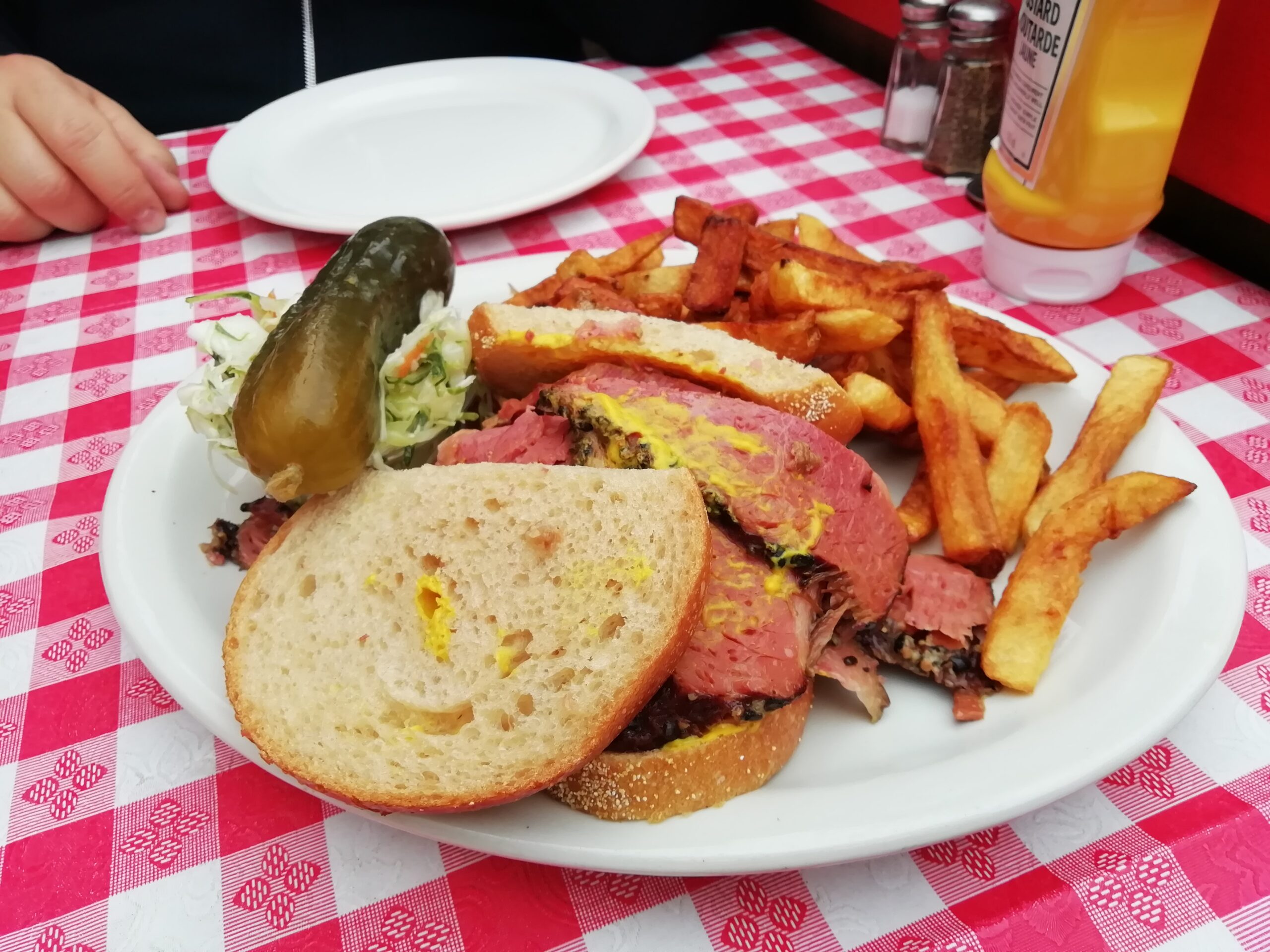
“How do ya wann it? Fatty or more fatty?” was the typical, gruff, heavily accented reply every time I used to walk into Montréal’s temple of great food (also known as Schwartz’s Deli) asking for a smoked beef sandwich. To be clear, there are many reasons why I love Montréal: its plethora of mouth-watering ultra-delicious, impossible to resist smoked beef sandwiches are certainly one of the most important.
Fact is, smoked beef is a way of life in the biggest city of La belle province, and in some cases, an art form. Trust me: smoked beef is cold cut heaven, a paradisiacal delivery of everything good in beef and bread and yellow mustard, the veritable king of charcuterie. Now, to the uninitiated, to the superficial, or to all those who just don’t know better, smoked beef resembles or could pass for pastrami. But I warn you, uttering that thought out loud and within earshot of any knowledgeable Montréaler is done only at your own risk and peril. And should you be really reckless and do so in the general vicinity of a normally calm-tempered, good-natured older habitant of Jewish descent, well, all I ask is that you kindly warn me ahead of time of your intentions allowing me to scamper away so as to not get any blood on my clothes.
Where’s the beef? Pastrami and smoked beef, so similar, so different
Yes, smoked beef is a Montréal institution, right up there with maple syrup and the cabanes à sucre, the Canadians, the Saint Lawrence, Ken Dryden’s iconic mask, the Underground City, the unbelievably cold winters, the Flower, Vieux- Montréal, the Expos that were oh-so close, beautiful Mount Royal and poutine (wait a minute: Poutine? Poutine?? OK, so the city doesn’t get everything right). But it is nothing like pastrami, surely just as delicious, but which should be viewed as a cousin of sorts.
It is generally held that smoked beef and pastrami have a common origin, in that both are most likely traditional Jewish-Romanian foods. The word pastrami and the preparation itself most likely descend from a Romanian product known as pastramă, a thinly sliced cured, cold smoked meat (but differently from our two meat heroes discussed here, not cooked) that’s traditionally made of mutton or pork and rubbed with spices like coriander, cracked black pepper, and paprika (there’s a very similar dish in Turkey, called pastırma, but made with beef). In fact, according to some experts, ‘pastırma’ means ‘to press’ or ‘to cure’ and that is the meaning and origin of the word in both Turkish and Romanian. From there descend the nobly delicious pastrami and smoked beef.
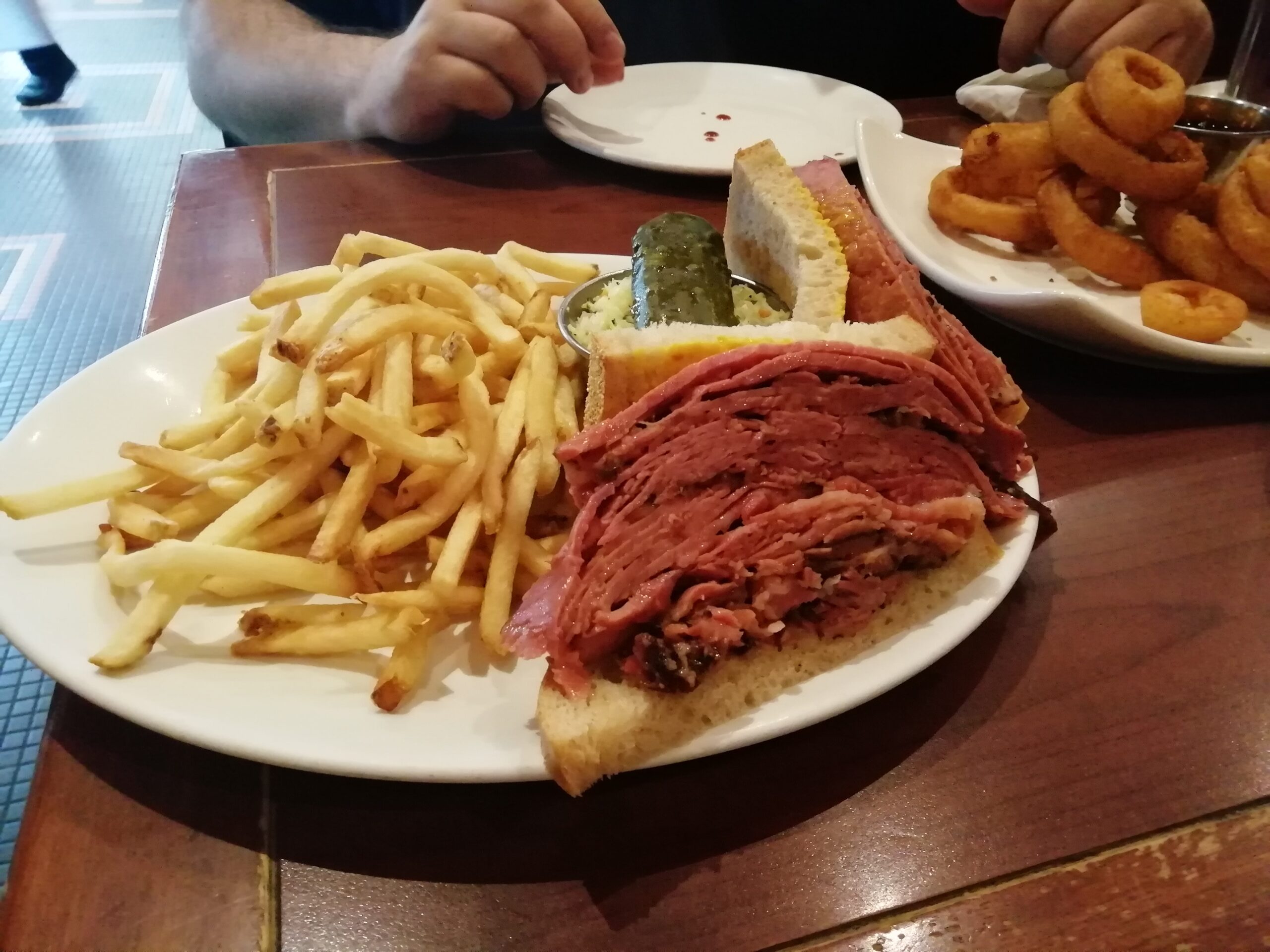
Both pastrami and smoked beef are cured, smoked and cooked beef dishes. For example, smoked beef is brined with a secret recipe, then dry-rubbed with more herbs and spices, and last but not least, smoked for roughly twelve to fifteen hours over hardwoods such as cherry wood and oak. But pastrami and smoked beef differ greatly (and I mean greatly), because of the type of cut and of the spices used. Relative to the cut of meat used, Montréal smoked meat is made with the brisket, whereas pastrami is made with the navel, or belly. The brisket is the fattier of the two cuts (and this even though the navel is a cut similar to belly, or what you would make bacon out of in a pig). In Canada, the navel cut all on its own is much harder to find because of the country’s British roots that have strongly influenced its culinary traditions (including beef cut habits). In fact, in Canada butchers historically refer to “whole brisket” (what in the USA would amount to brisket and navel). And so, it is that Canadian smoked beef sandwiches can be ordered fatty, medium, or lean, in which there are varying quantities of meat from each of the two parts of the whole brisket, with the higher or lower percentage of each of the two ultimately making for a leaner or fattier sandwich. In the case of the fattier sandwich, you can literally see the fat just ooze out of your smoked beef sandwich as you eat, which basically never happens (or at least, nowhere near to the same degree) with the leaner, tougher pastrami. That much admitted, be aware though that smoked beef is not fattier throughout the cut: what really characterizes smoked beef is a larger cap of fat, while its texture is more fibrous compared to the more marbled but tighter-textured American-style pastrami. Also, one of the secrets to the really soft smoked beef samples you’ll eat all over Montréal is the just right amount of steaming the beef undergoes prior to getting eaten.
Relative to the spice rub smoked beef is coated with, there is no sugar included in the rub. The mixture most commonly used is one of black pepper (whole peppercorns), coriander seed, garlic, and sometimes mustard seed, bay leaf, and other aromatic herbs. By contrast, pastrami is generally spiced with coriander and black pepper, and often, sugar. Traditionally, the smoked meat would marinate in its own juice for up to a month, and then would be hung inside smoke houses and smoked. However things are often done differently today (and not for the better) with many smoked beef producers (but happily not all) now marinating the meat only a few days (aromatic brines and nitrates will do the trick nicely but achieving the same level of flavour depth and complexity is quite another matter.) Cleary, the cost of the newer methodologies is lower than those of yesteryear. Say no more.
Smoked beef and Montréal
Smoked meat seems to have been part of Montréal’s fabric and culture since close to forever; but not surprisingly, given the importance of the object of contention, its origins are still being argued over. A few smoked beef luminaries (in fact, my favourite kind of luminary) believe the first person to have prepared the dish was Benjamin Kravitz, who had come to Canada after fleeing Lithuania in 1899 with Fanny Schwartz, his wife. Rather thoughtfully, the couple brought along with them the old family recipe of brisket-curing, and reportedly began serving smoked meat sandwiches out of their store on St. Laurent Boulevard in 1908. Others claim that Montréal’s smoked beef’s heyday began a little later, in 1928, when a Reuben Schwartz started selling it at his namesake deli, the aforementioned Schwartz’s, believed to be the oldest deli in Canada. However, Jason Lee of Montréal (the Tourisme Montréal newsletter that is not just remarkably well-written and up to date but also just plain fun to read), reports that historian Eiran Harris believes both of these purported origins to be erroneous. Apparently it was Aaron Sanft who arrived in the city from Romania and in 1884 founded Montréal’s first kosher butcher shop (at 560 Craig Street) and was the first to promote smoked meat. The advertisement records from those days would seem to attest this, as the words “smoked beef” are clearly visible (very interestingly, “corned beef” and “same quality as New York” were also part of the same advertisement). Interesting to say the least, but at this rate, I’m not sure we’ll ever get to the bottom of the historical Montréal smoked beef caper.
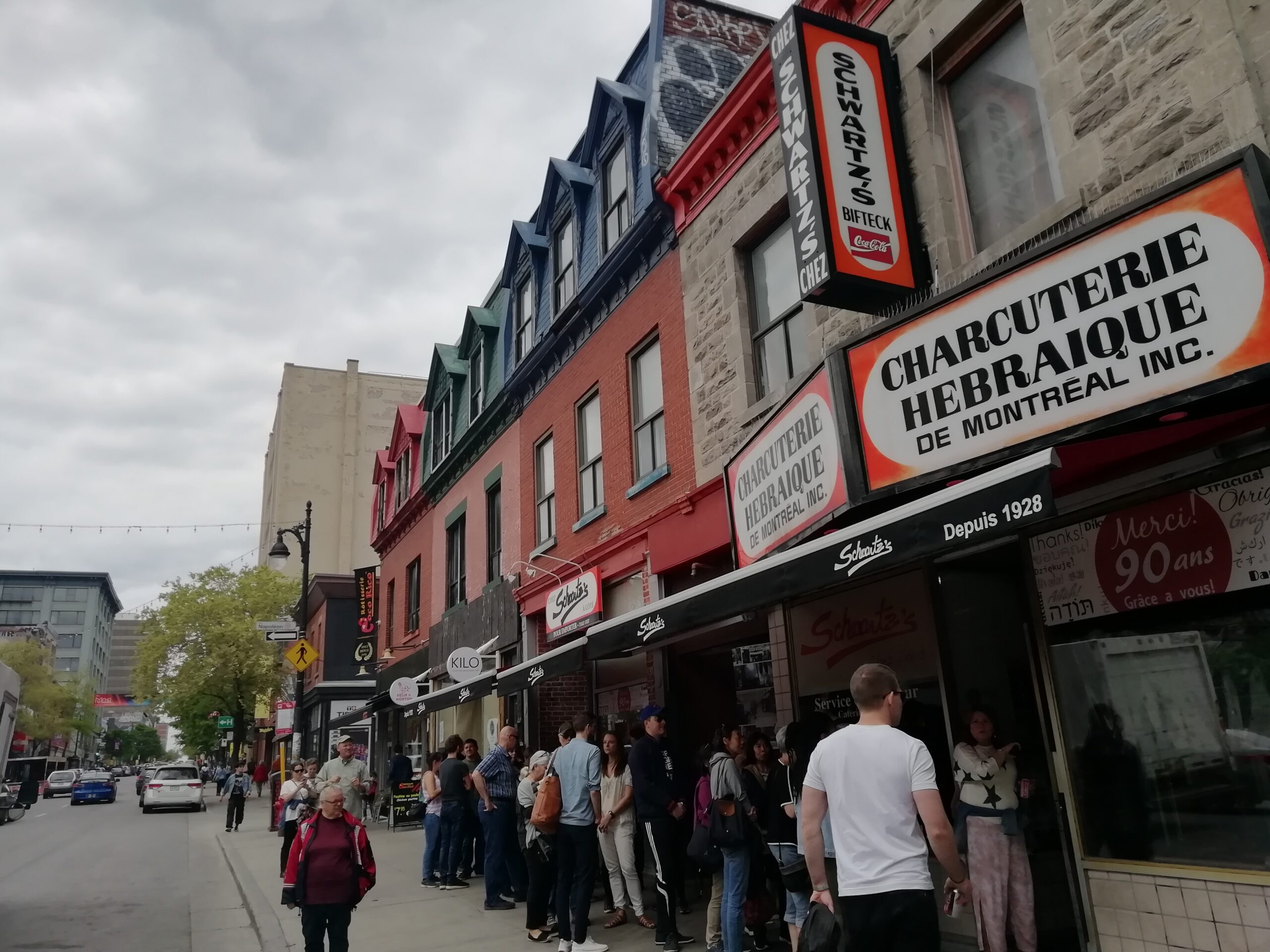
Doing it like a Montréaler
Any self-respecting Montréal smoked meat sandwich will be several layers thick and piled relatively high on a plate, though with its large, flat rye bread base there is no risk of it falling apart or turning over. It almost always comes served with sliced pickles and coleslaw, not to mention yellow mustard (the fancier stone ground mustard is nowhere to be seen at any of Montréal’s best smoked beef shops and they look at you strange should you ask for it; and while I’ m at it, as I never cease to be amazed by the things that turn some people on, I will just warn you to ask for ketchup or BBQ sauce at your own risk and peril). Before you order, you should make sure to tell them how you want the meat: lean, medium or fatty are usually your three options. Clearly, should your cardiologist be one of those charming fellows that likes to hover over your eating habits like a falcon looking for food, you might be inclined to go for the “lean” (drier meat sliced from the brisket flat), but be aware that this is almost always the least exciting, least memorable and least flavourful smoked beef option at your fingertips (and taste buds). By contrast, “medium” is where most of the fun is at (most of the flavour too), and not surprisingly, it is also the most popular cut (in this case, from the middle of the brisket). Your third or “fatty” option, nowadays more often than not called by the more politically correct term of “old-fashioned”, is a combination of medium and fatty slabs of beef that are usually cut thicker than those of options one and two. Those are the three common options, though as I told you earlier, at Schwarz’s they speak of “more fatty” too, and I’m not quite sure what that refers to. Then again, I probably don’t really want to know.
Actually, with the changing times, today’s fashionable-sensitive aesthetic, and the prevailing follower mentality, once forgotten foods such as these poor man’s cuts of beef (brisket and navel, filet and porterhouse they are not), or simply foods that were never very “in” once, have now become de rigueur. Consequently, prices for what were once considered to be mere by-products of the really good cuts the cow had to offer have risen accordingly. What this means is that sometimes you will find yourself handed an unacceptably tough and much too lean smoked beef that is made with much cheaper cuts like top round (pastrami has the same problem). Though some people might like the idea of a cardiologist-friendly sandwich, the experience is nothing like the real thing. And given that you don’t eat this stuff every day, it makes no sense to eat something that is so much less tasty than the real thing.
Speaking of the “real thing”, what do you think is the best pairing with smoked beef? Believe me, as much as I like wine, nothing beats a nicely cold (but not ice cold) Cherry Cola. The soft drink’s gassiness helps cut through the fat, and its sweetness helps contrast the inherent saltiness of the meat while also modifying the sensation of body of both wine and food in your mouth. For the same reasons, a good quality Lambrusco Grasparossa or Salamino wine (Lambrusco di Sorbara is a little too classically dry and light), and even better (much better) an Amabile or Dolce version of the same, proves to be another marriage made in heaven. For the learned among us a good Lettere or Gragnano would work well too, though I think a hint of sweetness in your wine is to be preferred when making your final choice.
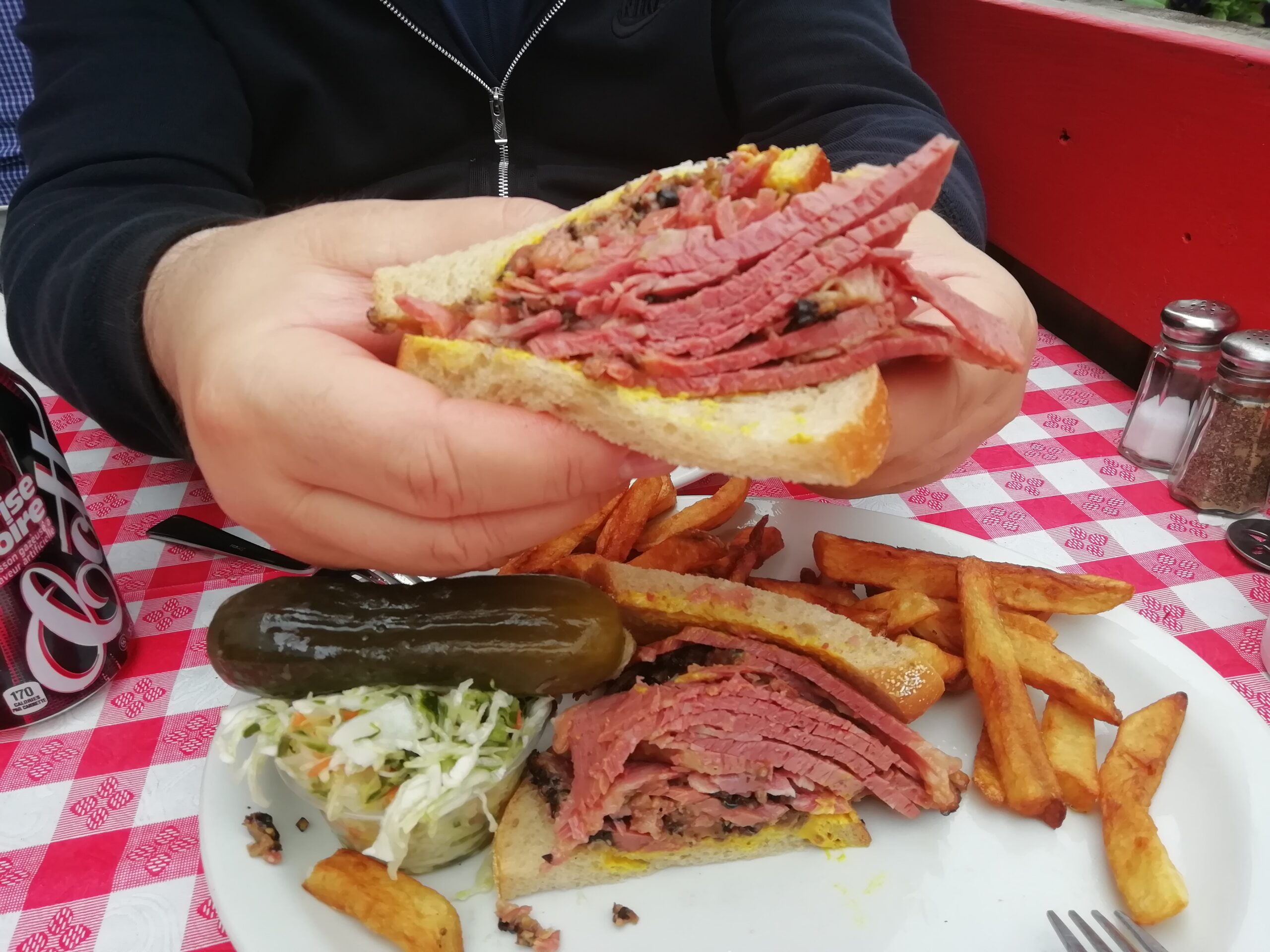
I have been (very happily) eating at most of the following smoked beef delis for the better part of the last forty years; I have tried all of them as recently as 2017-2019. Unfortunately, because of the Covid pandemic and the necessary safety travel and gathering restrictions, I have not been able to get back as often as I’d like. Furthermore, not all the places on this list might be currently open for business at the time this article will appear in my TerroirSense Wine Review. Hence, check before you decide to go.
The fab five (and five more worthy of your tastebuds)
The following are my choices as Montréal’s best smoked beef purveyors. Each has its strengths and weaknesses, but for the most part, nobody does it better than the folks at these addresses. Be aware that I lived in Montréal for almost four years and during that time especially (but all my life really) ate more smoked beef sandwiches than is either logical or even healthy. And so, I know exactly what I am talking about and I take my smoked beef very seriously (admittedly, maybe too seriously). For this reason, you will not find on my list some well-thought of spots that include non-traditional elements such as slices of Swiss cheese or challah buns. While those might be very tasty renditions of smoked beef, they are also not what I consider to be typical of the Montréal smoked beef experience. No matter, try the names on the following list and I guarantee you’ll undoubtedly come away enjoying your traditional, historically accurate smoked beef dining experience that harkens back to traditions, the hard work, and memories of many lives past. And it really shouldn’t be otherwise in Montréal. After all, in Québec it is really normal, fair even, to Je me souviens.
The incontournables
On the busy, long and not so winding Saint Laurent boulevard (the next street over from Avenue du Parc, where I spent my formative years in beautiful French-Canadian Montréal, the world’s third largest French-speaking city), you’ll find the absolutely unmissable Schwartz’s Deli (3895 Boulevard Saint-Laurent). Admittedly, Schwartz’s is unmissable not just because the smoked beef is so good, but because you’ll see the lineup of people patiently standing outside of the small front door long before you get anywhere near (be smart, or act like a local, and avoid the lineup by ordering at the take-out counter next to the cramped small dining spot’s entrance). But in the end, the pain of having had to wait your turn will have been worth it: for here the smoked beef sandwich is part dish, part artwork, part faith, part intellectual awakening, part history, part memory. The sum of all those parts amounts to so much more than the individual components that are yet necessary for Schwarz’s creation to reach its uniquely exalted level. It would be surprising if it were otherwise: given that the place has been serving goodies for something like ninety years, they know their way around a brisket. Just be well aware of the password: “fatty or more fatty?” Because nobody at Schwartz’s will ever ask you if you want your smoked beef lean. I always love a good story and am a sucker for traditions, and Snowdon Deli (5265 Boulevard Décarie) serves both up in spades. After World War II, brothers Joe and Abe Morantz decided to take a page out of their sister’s Pearl playbook (or perhaps cookbook?) who was manning a very successful deli on rue Van Horne. And so they too opened their own deli in 1946. But there’s no two without a three as they like to say in Italy (but I guess in Montréal too) and so brother Phil joined his two male siblings two years later. When the rigors of Time came calling, they decided to pass the baton to their faithful employee John Agelopoulos, who after an honoured forty-year long career alongside the brothers teamed up with Abe’s son Ian to continue carrying the smoked beef torch. Today it’s their children and Phil’s grandson who do the same, ensuring that the Snowdon name lives on. All of which wouldn’t mean a thing if the smoked beef sandwich wasn’t just so darn good, in fact one of the top three or four in the city. See for yourself and get ready not just to titillate your taste buds but to also breathe in deep the rarefied air of Montréal’s beautiful old days. One of the city’s most famous smoked beef addresses and one that is much loved by Montréal’s denizens is Le Roi du Smoked Meat (6705 rue Saint-Hubert). No doubt, it’s an absolutely beautiful vintage diner menu with a knockout retro-chic appeal (the red booths are worth the visit alone), but I think the depth and nuance of their smoked beef is just a smidge below the best on this list. Maybe it’s just my imagination or perhaps it has to do with the fact they reportedly do not brine their own brisket, I’m not sure; but it is only fair to say that the “Smoked beef King” delivers a very satisfying smoked beef dining experience nonetheless, one that I endorse wholeheartedly. For many Montréalers, there is no better smoked beef sandwich than that of Reuben’s Deli & Steak House (1116 Rue Sainte-Catherine Ouest): for sure, there are fewer that are as big as some of the truly massive versions served here. Decorated in an art deco style that some will find charming and others tasteless, Reuben’s serves up not just a taste of wonderful smoked beef but of Old Montréal too, in my mind always a plus. Another plus is the fact that it is open past midnight: let’s face it, it’s always good to know there’s a smoked beef port waiting for you in any storm. Apparently, because of the pandemic and related restrictions, the deli has not surprisingly been unable to serve its loyal customers of late, but the menu is available on Uber Eats. Last but not least, the slightly out of the way venue of Smoke Meat Pete (283 1ère Avenue, L’Île-Perrot) to the west of the city’s downtown core is all the rage now amongst the local smoked beef cognoscenti. Founded by Peter Varvaro (if you know even just a little about the city and its smoked beef, then you’ll recognize that name as it’s that of Pete’s father, also named Peter Varvaro, the founder of Main Deli -see below). Junior worked along with his dad for something like twenty years prior to setting off on his own and creating a smoked beef address that many locals swear by, lifting it to the very best the city has to offer. For sure, the generally thicker cut, very juicy, perfumed slices of pink meat will have you grinning from ear to ear at every bite, and I for one recommend the drive out there.
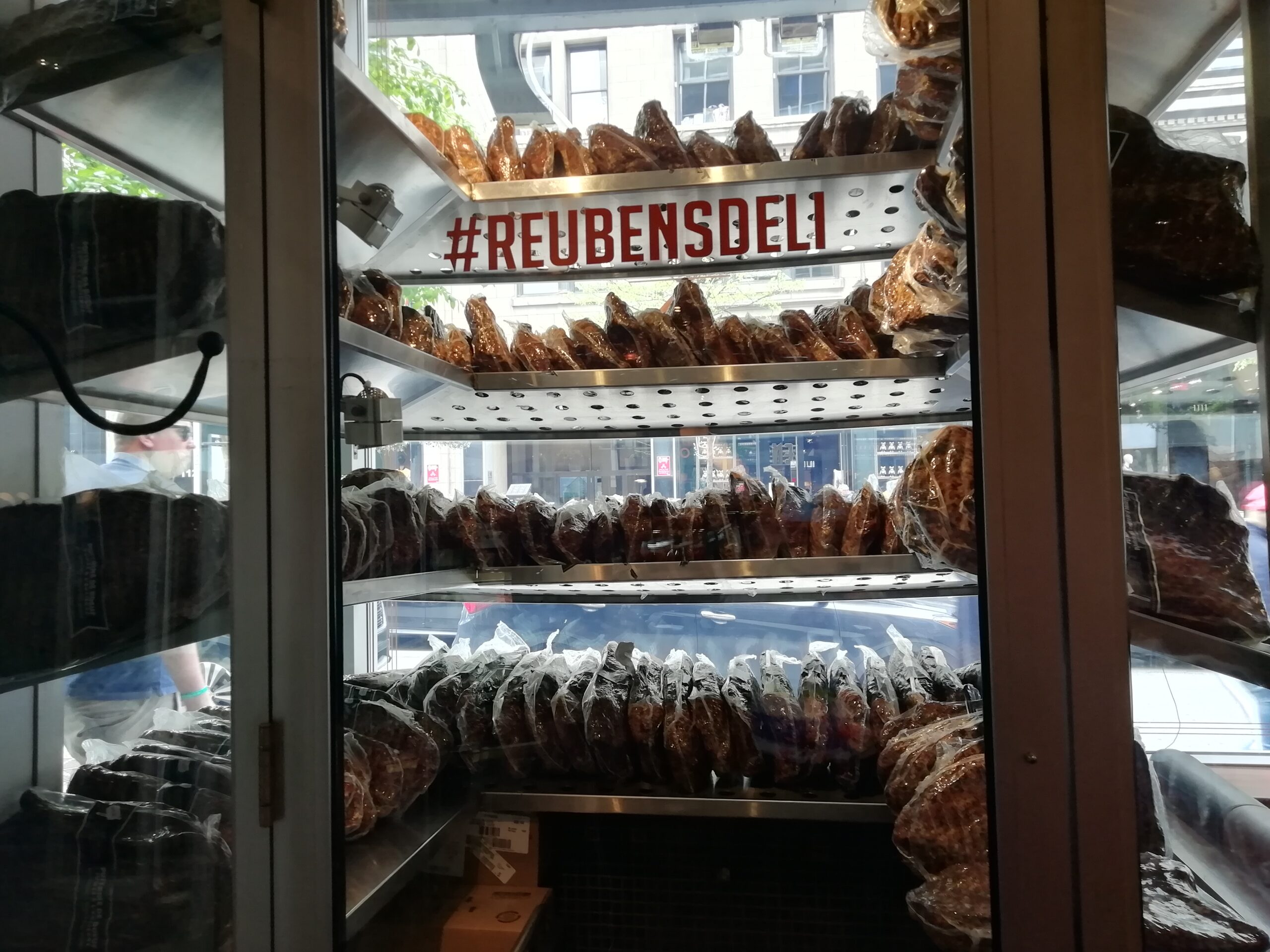
Five more beauties
Of course, if lineups aren’t your thing because you have the world to save or more important things to do, standing around in the line at Schwartz’s may not be for you. In that case you can always try hopping across the street (while trying hard not to get run over by the always enthusiastic Montréal drivers) to the Main Deli (3864 Boulevard Saint-Laurent). It’s no doubt a much more comfortable eating venue than its famous neighbour across the street, one that also has pleasant tables at which to sit and eat outside when the weather allows. At the Main Deli they have been manning the stoves and the counter for forty years and counting, so clearly, they do know a thing or two about smoked beef here. For the longest time, the secret recipe guaranteed a pretty good smoked beef sandwich, but my recent forays have left yearning for meat with a little more complexity and depth of flavour. Maybe it’s true that the sandwich hasn’t been quite the same ever since owner Peter Varvaro passed away in 2013 (the deli stopped smoking the meat on its premises after that), but the sandwich is still a pretty good one. And besides, I love the idea of eating where Leonard Cohen also used to hang out.
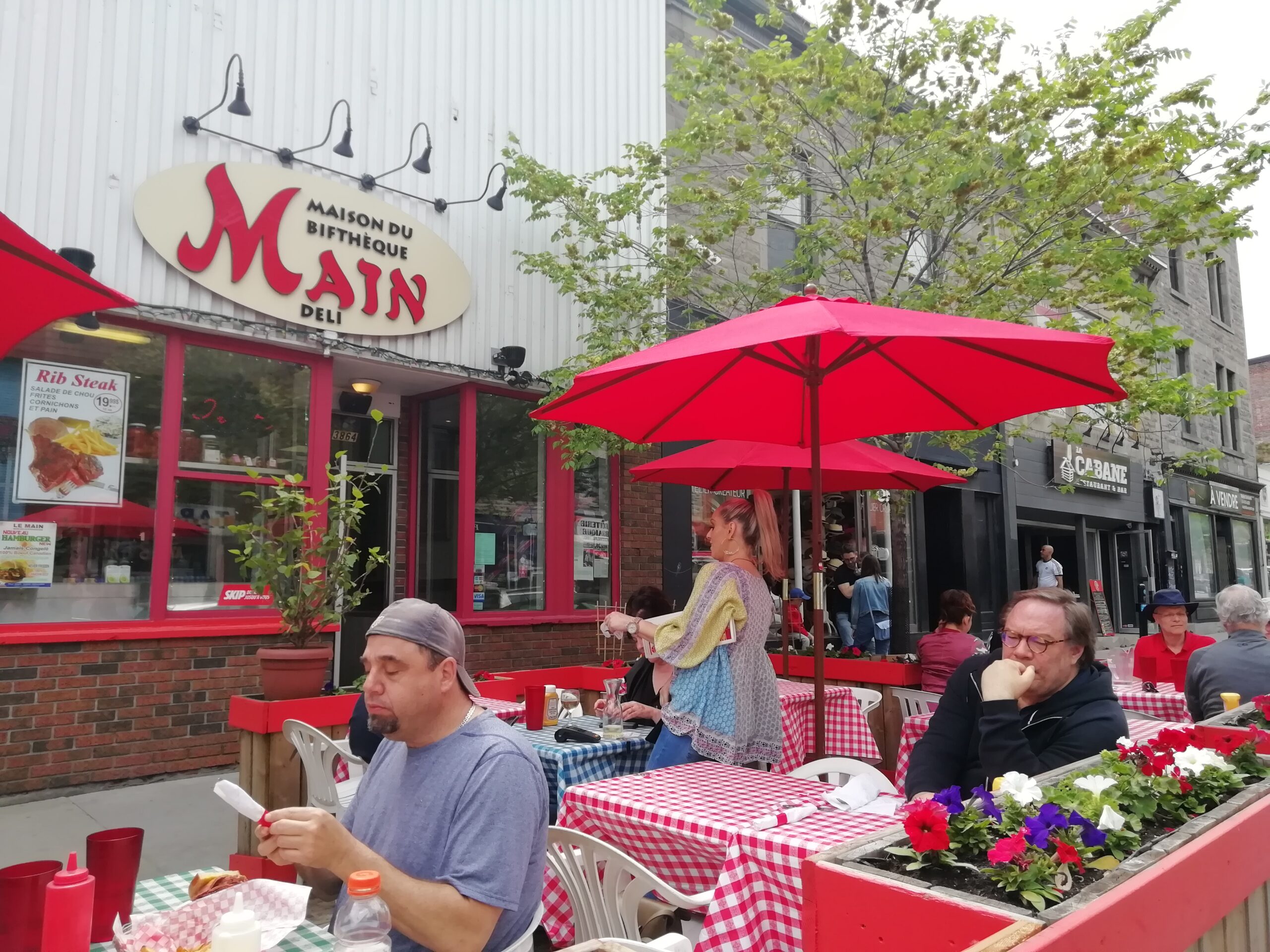
Dunn’s Famous (multiple locations, but I suggest going to the original, at 1249 Rue Metcalfe) Dunn’s Famous opened more or less at the same time as Schwartz’s (so it’s going on ninety years plus), but smoked beef became a big part of its business, if not its core business, only in the 1970s. Besides their signature smoked meat (which you will find to be typically slightly leaner and less spicy than that of Schwartz’s or Reuben’s, for example), you can dig into all the diner classic foods from burgers to fries. Extremely successful, the original has now expanded all over the city and the rest of Canada, so you won’t be short of choices of where to get a good smoked beef sandwich should you not be in what was once Ville Marie. Another very solid choice for your smoked beef cravings is Jarry Smoked Meat (6549 rue Jarry Est). Jarry has been in business since 1974, and it doubles not just as a solid smoked beef address situated in the Saint-Léonard neighbourhood, but also as a highly typical Montréal deli where you can breathe in the same air that locals do. Another nice touch about Jarry is that it is open 24/7, giving you the perfect opportunity to get a smoked meat sandwich fix any time you need one. Add to that very good service (better than the average) and very fair price, and Jarry will have you singing the Montréal smoked beef blues all day long. Lester’s Deli (1057 Bernard Avenue Ouest, but there’s a branch at the airport too) has been around since 1951 and proudly states it serves the “only and unique authentic” Montréal smoked beef. I’m not sure how well that sits with some of his brisket-cutting colleagues, but so be it; for sure, the deli has an authentic, appropriately semi-dark and old style feel to it that avoids falling into the tourist-trap look of some of the city’s other smoked beef purveyors. The sandwich is certainly towering and imposing enough and I find the meat to be slightly spicier and more peppery than most in the city, something I welcome, but it’s also less tactile and textured than most, so those who like a fleshier, thicker mouthfeel to their smoked beef might prefer another venue’s version. Different strokes for different folks, I guess. Located east of the city in the Rosemont–La Petite-Patrie neighbourhood, Beaubien Deli (4023 Rue Beaubien Est) is also not to be missed. A traditional diner like they truly don’t make them anymore, Beaubien serves up full menu of diner classics (burgers, pizza, salads, BBQ chicken, steaks) but go for the smoked beef and you won’t regret it. It’s big juicy and perfumed. One last mention is deserved. I have not been to George’s (3750 Boulevard Saint-Martin Ouest, Laval), but people whose palate I trust have spoken very well of it to me. It’s been open for more than twenty years, so obviously I am remiss here, and even more so with the knowledge that owner George worked at Schwartz’s for thirty years plus before trying his luck out on his own. It seems to have certainly worked out for him, and the fact that the brisket is reportedly dry-rubbed with a secret house spice mix and aged and smoked onsite, is no doubt part of the reason explaining that success.
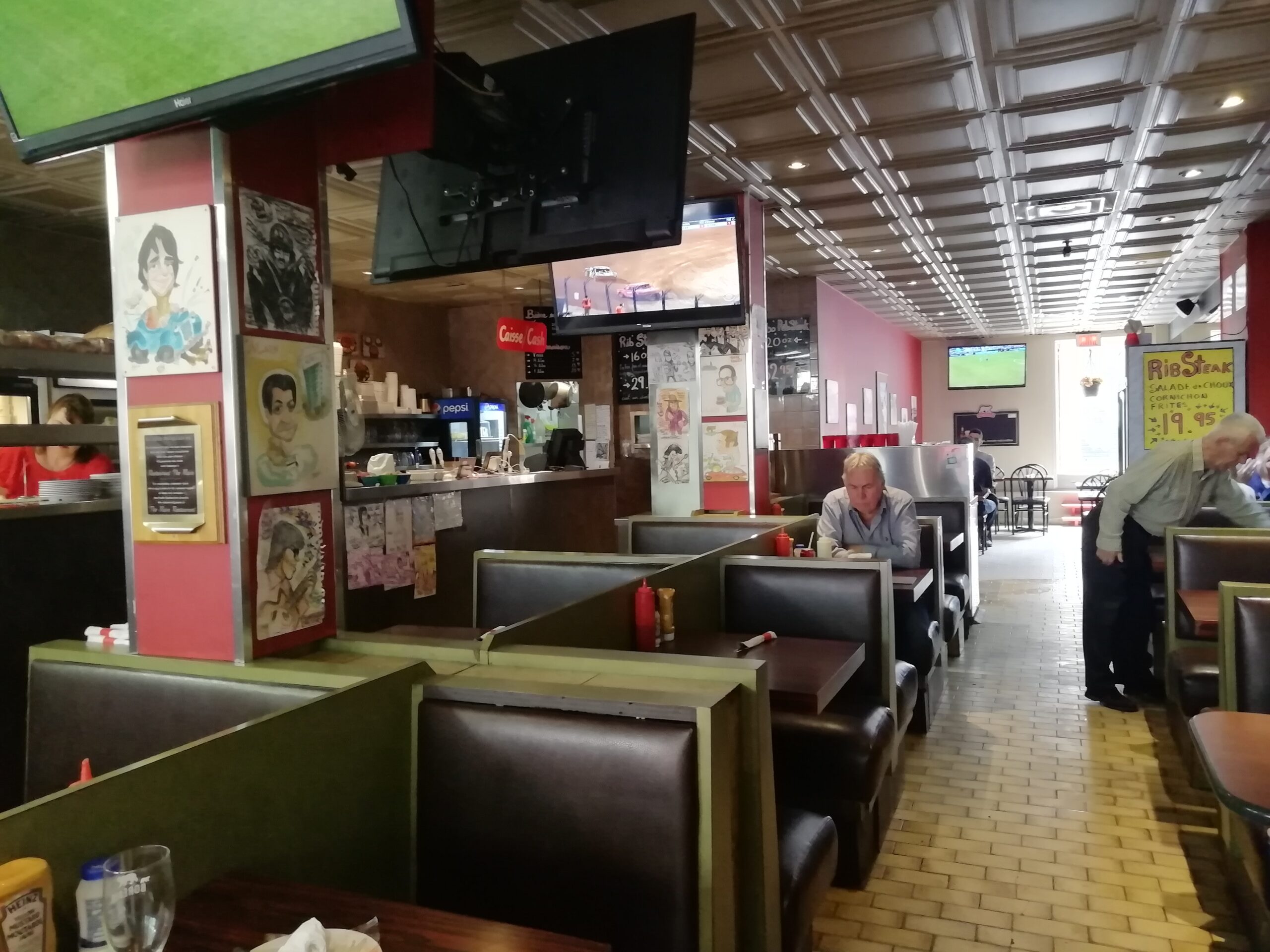

 中文
中文
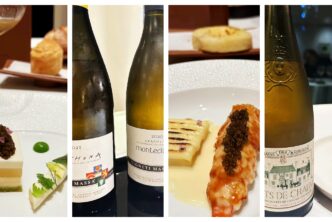

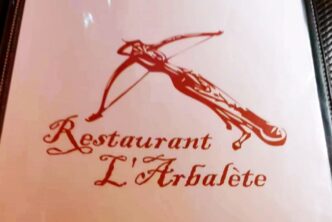
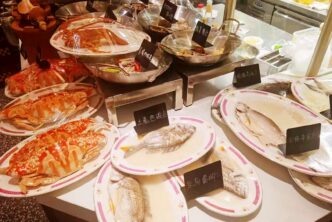
Wow, an article about Montreal Smoked Meat! As a (former) Montrealer – though once a Montrealer, always a Montrealer – I thought I knew a lot about smoked meat but your article seriously expanded my knowledge! For the record, I am a Lester’s Deli fan (I grew up near there and we used to go regularly when I was a kid). Fully agree that a nice smoked meat meal is ‘de riguer’ when in Montreal.
Ciao there, i totally get you, I’m a big fan too of Lester’s, lovely resto and ambience and very very good sandwiches. Can’t wait to get back there! And you’re right, once a Montrealer, always a Montrealer…I wasn’t born there (rather, Toronto) but I lived there four years and I still think of myself as someone of the city!
ian
Ciel! Ian was in Montreal…
Next time you come tell me before, I will throw a party in your honour.
Tell me long enough before, and I will commission a Te Deum.
Richard
PS: That was an involved article indeed celebrating the all 2 delicious/ rich ( dial 911 please!) modest and famous Montréal delicacy…
Ciao there, i totally get you, I’m a big fan too of Lester’s, lovely resto and ambience and very very good sandwiches. Can’t wait to get back there! And you’re right, once a Montrealer, always a Montrealer…I wasn’t born there (rather, Toronto) but I lived there four years and I still think of myself as someone of the city!
ian
Ciao Richard, no, I wasn’t in Montreal recently, i wish I could have been, but as the article states the guide refers to my visits just prior to the Covid breakout…I checked with some of my locals and they all felt the guide was still up to date and so i went ahead and published it; but really, it was just an excuse to speak about Montreal’s wonderful smoked beef, it’s history and deliciousness. Of course, when I do come to beautiful old Ville Marie I will let you know as I look forward toi seeing you at lunch or dinner with all our other friends.
ian
You know Ian, on the French side of Montréal we always say “smoke meat” and not beef 😉
Call to action: Now I feel the urge to jump in the car and try those in Laval and the West Island as well…
Ciao mon ami,
no, unfortunately i was not in Montreal, or I would have certainly reached out and invited you for lunch or dinenr….as the article says, the reviews are based on visits to the delis done just before the Covid breakout, but I verified with some local friends who all felt the deli reviews were up to date and could be useful published as such. Really the piece ants to tell people about a specific food product that is not just excellent, but that typifies the beautiful city of Montreal…and so it gave me the excuse to write about smoked beef’s history, the way it’s made, how different it is from pastrami and so firth…I hope to see you soon once Covid finally allows us to travel once again, but safely.
Bonjour Ian,
J’ai adoré lire cet article qui m’a remémoré les deux fosi où je suis allé manger du Smoked beef chez Schawartz…un délice!
Mon seul mauvais souvenir: le cherry coke qu’on m’a conseillé de boire avec! Un verre d’un puissant vin rouge aurait été tellement meilleur!
A bientôt Ian!
Je ne savais pas que tu étais un aimant de la mythique smoked beef..on devra y aller ensemble une fois! A propos, mon article sur les nouveaux millésimes d’Alsace va sortir en deux-trois semaines au plus tard, donc tu auras beaucoup d’autre encore à lire!